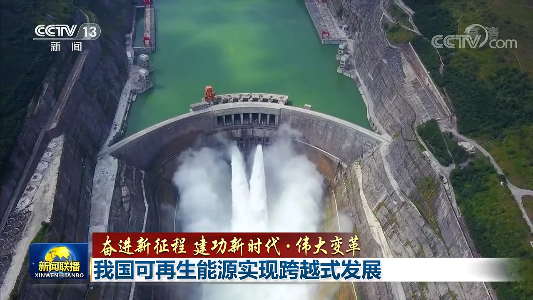
General Secretary Xi Jinping pointed out that greater emphasis should be placed on promoting the development of new energy and clean energy. Since the 18th National Congress of the Communist Party of China, China's renewable energy, represented by hydropower, wind power, and photovoltaic power generation, has achieved leapfrog development. Its installed capacity has ranked first in the world, the proportion of power generation has steadily increased, and the effects of energy structure adjustment and carbon reduction have gradually emerged.
From January to May this year, the newly added installed capacity of renewable energy power generation nationwide reached 43.49 million kilowatts, accounting for 82.1% of the country's newly added installed power generation capacity. Renewable energy has become the main body of China's newly added installed power generation capacity. However, just ten years ago, the proportion of new energy power generation in China was only 2.7%. The energy structure was dominated by coal, with low energy efficiency. While supporting China's rapid economic development, it was accompanied by problems such as severe damage to the ecological environment caused by energy production and consumption.
At the sixth meeting of the Central Financial and Economic Affairs Commission in June 2014, General Secretary Xi Jinping creatively put forward a new strategy for energy security, personally guiding and promoting the revolution in energy consumption, energy supply, energy technology, and energy system, comprehensively strengthening international cooperation, and striving to build a clean, low-carbon, safe, and efficient energy system. Since the 18th National Congress of the Communist Party of China, a series of heavyweight plans and policies in China's energy sector have been intensively introduced, forming a strategic planning system to promote the energy revolution. At the same time, in-depth promotion of reforms in the electricity, oil, and gas systems has been carried out, especially actively cultivating strategic emerging industries in the energy sector, and clarifying 15 key directions for energy science and technology innovation.
Over the past decade, China's total installed capacity of renewable energy power generation has reached 1.1 billion kilowatts, with the installed capacity of hydropower, wind power, photovoltaic power generation, and biomass power generation ranking first in the world. Among them, the combined grid-connected installed capacity of wind power and photovoltaics has reached 670 million kilowatts, nearly 90 times that of 2012.
Over the past decade, China has formed a relatively complete renewable energy technology and industrial system. In the field of hydropower, it has the world's largest independent design and manufacturing capacity for million-kilowatt hydropower units. Photovoltaic power generation technology has iterated rapidly, repeating the world record for battery conversion efficiency. Wind power technologies such as low wind speed, typhoon resistance, ultra-high towers, and ultra-high altitude are among the world's leading, and 10-megawatt offshore wind turbines have begun mass production.
Over the past decade, renewable energy has contributed to China's ecological civilization construction. In 2021 alone, the development and utilization scale of renewable energy in China was equivalent to 753 million tons of standard coal, reducing carbon dioxide, sulfur dioxide, and nitrogen oxide emissions by approximately 2.07 billion tons, 400,000 tons, and 450,000 tons respectively.
In January 2022, General Secretary Xi Jinping clearly proposed at the 36th collective study session of the Political Bureau of the Central Committee that greater efforts should be made to plan and build a new energy supply and consumption system based on large-scale wind and solar power bases, supported by clean, efficient, advanced, and energy-saving coal-fired power around them, and supported by stable, safe, and reliable UHV power transmission and transformation lines.
Today's China, from deserts and gobi to the blue sea, from the roof of the world to the vast plains, shows vibrant vitality in the development of renewable energy. On the Jinsha River, the Baihetan Hydropower Station, the second largest in the world, has accumulated clean electricity production exceeding 30 billion kilowatt-hours, continuously improving China's power supply guarantee capacity. In Wenling, Zhejiang, the country's first tidal and solar complementary photovoltaic power station has been put into operation. The construction of large-scale wind and solar power bases in China, focusing on deserts, gobi, and desert areas, has also begun. At present, more than 95 million kilowatts of the first batch of large-scale wind and solar power base projects with a total capacity of about 100 million kilowatts have been started. During the "14th Five-Year Plan" period, the increment of renewable energy power generation in China will account for more than 50% of the increment inthe whole society electricity consumption, and the power generation of wind and solar energy will double.
(Source: CCTV.com)


